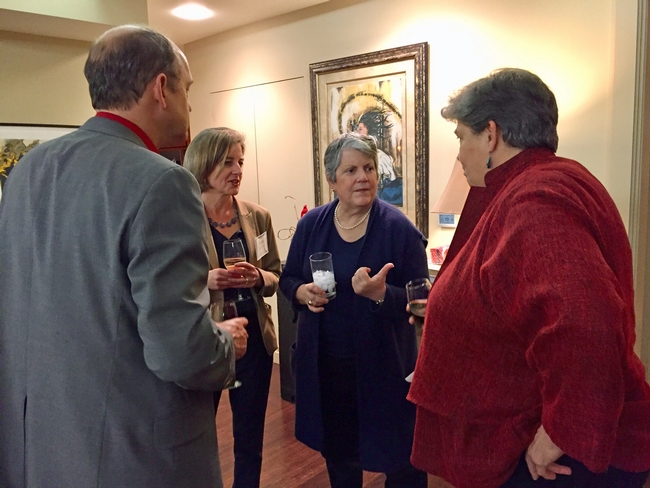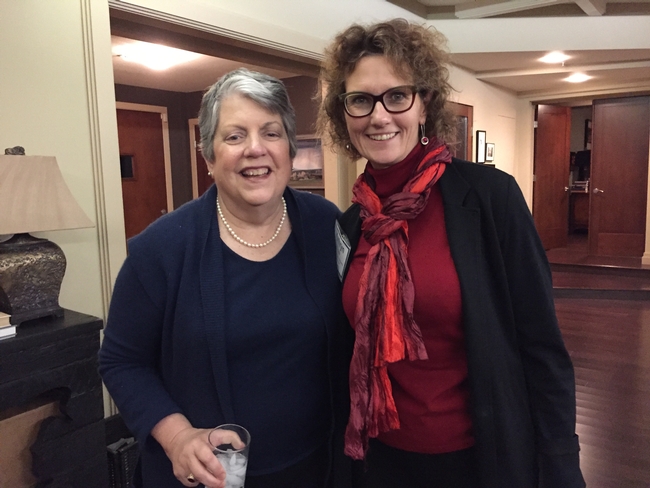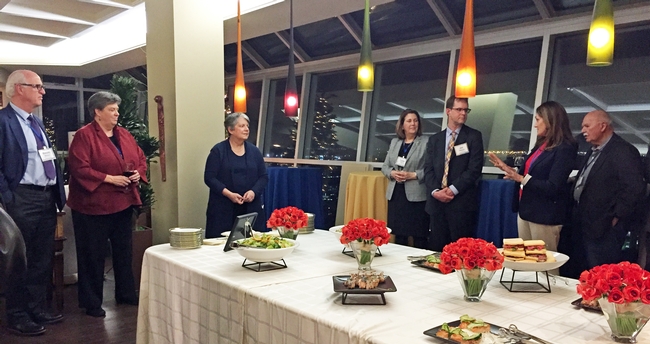PAC welcomes 4 new members, discusses future role
Expanding ANR's academic footprint, leveraging citizen science and applying research to policy were on the agenda for the UC President's Advisory Commission on Agriculture and Natural Resources when they met Dec. 18 in Oakland at UC Office of the President. The commissioners also discussed how to ensure the long-term success of UC ANR and the role of the PAC in helping to sustain UC's Agriculture and Natural Resources research and Extension mission.
Jean-Mari Peltier, who succeeded Don Bransford as chair, welcomed new commissioners: Celeste Cantu, vice chair of the San Diego Water Quality Control Board; Lucas Frerichs, associate director of state policy for The Nature Conservancy; Corinne Martinez, partner in the Martinez Family Limited Partnership and Berryessa Gap Vineyards; and Cher Watte, executive director of the California Asparagus Commission. Mike Mellano, CEO of Farming for Mellano & Company, also began serving as vice chair.
UC President Janet Napolitano was unexpectedly summoned to meet with Governor Gavin Newsom in Sacramento, so she met with the group later in the day.
Academic footprint
Vice President Glenda Humiston gave the commissioners an update on UC ANR activities and plans to expand the academic footprint. Although a flat budget has constrained hiring, ANR partnered to fund nine academics, which will provide salary savings of $700,000 over 5 years. With $1.6 million from the California Department of Food and Agriculture, UC ANR hired 14 community educators for 3 years. The UC Presidential Matches leveraged six donors to provide $6 million for UC ANR endowed positions.
She showed a series of maps, explaining how UC ANR is trying to fill positions by discipline and location in the state.
Humiston lamented that most UCCE advisors serve more than one county. “Multicounty assignments are not ideal,” she said. “This is a big state -- 30 of our counties are bigger than other U.S. states. We've got to get more people out in the field.”
To meet the evolving needs of California, the division will seek to hire academics to address farm mechanization, pest management for organic agriculture, fire science,agritourism and community and economic development, in addition to current positions.
Engaging stakeholders
To give the PAC members a broader perspective of the ways UC ANR connects with the public beyond UC Cooperative Extension advisor and community educator interactions with clientele, Humiston invited speakers from within and outside of UC ANR.
Heidi Ballard and Ryan Meyer of the UC Davis Center for Community and Citizen Science and Mark Bell, UC ANR Vice Provost for Strategic Initiatives and Statewide Programs, discussed opportunities for expanding citizen science with UC ANR.
Yana Valachovic, UC Cooperative Extension director and forest advisor for Humboldt and Del Norte counties, described how she engages stakeholders and policymakers in her region. She is an active member of the California Fire Science Consortium to educate the public – including regulatory agencies, the insurance industry and community planners -- about fire. Because of her expertise, legislators have asked Valachovic for advice in crafting policy for forest management and wildfire.
“All of our academics have expertise,” Humiston said, “but not everyone is comfortable talking to legislators.”
Anne Megaro, government and community relations director; Lorna Krkich, executive director of development services; Linda Forbes, director of strategic communications; and Jim Downing, director of publishing, described the functions of their units.
Krkich reported an 8% increase in donations and a 79.4% growth in Giving Tuesday donations over the past two years.
Breakout sessions
The participants, seated at tables of four to six people, discussed the following questions:
1. What are your recommendations on actions needed to ensure the long-term success/sustainability of UC ANR? (including communications, programming, expanding reach, government relations, fund development, etc.)
2. What should the role of the PAC be in helping to sustain UC ANR?
3. What will make your membership/participation on this Commission personally meaningful?
Some of the recommendations for ensuring long-term success included training academics to be spokespeople, taking funders on tours to see firsthand the benefits resulting from UC ANR research and extension, and educating the new UC president about UC ANR. The commissioners also suggested crafting messages about UC ANR that are easy for the public to understand.
PAC members offered to introduce UC Cooperative Extension directors to other influencers and to tell people about the value of UC ANR. They asked to receive information about UC ANR activities more often than the biannual meetings and Connected newsletters, including calls for specific actions that PAC members could take to help.
Deans Helene Dillard, David Ackerly, Kathryn Uhrich and Michael Lairmore gave campus updates, then the commissioners met with President Napolitano at her residence.
Several people asked Napolitano about the search for her successor. She explained the presidential search process and encouraged the PAC members to participate in the town halls and to submit their suggestions for criteria for candidates to UCPresidentSearch@ucop.edu.
The PAC will meet next in the spring.





